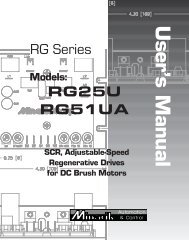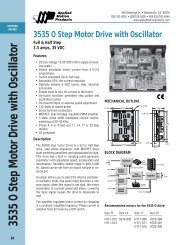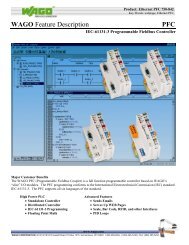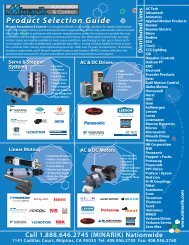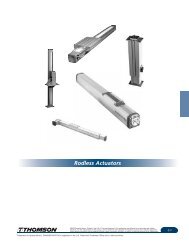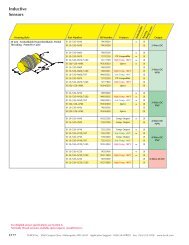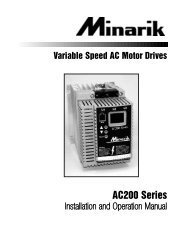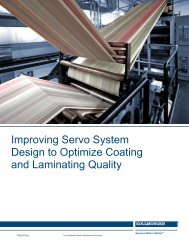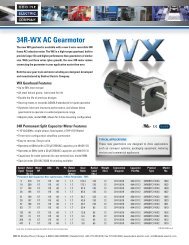You also want an ePaper? Increase the reach of your titles
YUMPU automatically turns print PDFs into web optimized ePapers that Google loves.
<strong>AB1A</strong>-<strong>3U</strong> <strong>Driver</strong><strong>User</strong> <strong>Manual</strong>March 2004Nanomotion Ltd. POB 223, Yokneam 20692, IsraelTel: 972-4-959-0862 Fax: 972-4959-0995Web Site: www.nanomotion.netE-mail: nano@nanomotion.comP/N: AB<strong>3U</strong>-458-000-C
CopyrightCopyrightThis document contains proprietary information of Nanomotion Ltd., and Nanomotion Inc., and maynot be reproduced in any form without prior written consent from Nanomotion Ltd. and NanomotionInc.No part of this document may be reproduced, translated, stored in a retrieval system or transmittedin any form and by any means, electronic, mechanical, photographic, photocopying, recording, orotherwise, without the written permission of Nanomotion Ltd.Information provided in this document is subject to change without notice and does not represent acommitment on the part of Nanomotion Ltd.Copyright March 2003, Yokneam, Israel. All rights reserved.All products and company names are trademarks or registered trademarks of their respectiveholders.Limited WarrantyNanomotion Ltd. (hereinafter NM) warrants the product (other than software) manufactured by it tobe free from defects in material and workmanship for a period of time of one year (except thoseparts normally considered as consumable/expendable components such as motor conditioningbrushes). The warranty commences thirty (30) days from the date of shipment.NM warrants those parts replaced under warranty for a period equal to the remaining warrantycoverage of the original part.NM’s sole and exclusive obligation under this warranty provision shall be to repair, or at its soleoption exchange defective products or the relevant part or component, but only if: (i) the Purchaserreports the defect to NM in writing and provides a description of the defective product and completeinformation about the manner of its discovery within ten (10) days of its discovery; (ii) NM has theopportunity to investigate the reported defect and determines that the defect arises from faultymaterial, parts or workmanship; and (iii) the Purchaser returns the affected product to a locationdesignated by NM. These provisions constitute the exclusive remedy of the Purchaser for productdefects or any other claim of liability in connection with the purchase or use of NM products.This warranty policy applies only to NM products purchased directly from NM or from an authorizedNM distributor or representative.This warranty shall not apply to (i) products repaired or altered by anyone other than thoseauthorized by NM; (ii) products subjected to negligence, accidents or damage by circumstancesbeyond NM control; (iii) product subjected to improper operation or maintenance (i.e. operation notin accordance with NM Installation <strong>Manual</strong>s and/or instructions) or for use other than the originalpurpose for which the product was designed to be used.NM shall not in any event have obligations or liabilities to the Purchaser or any other party for lossof profits, loss of use or incidental, increased cost of operation or delays in operation, special orconsequential damages, whether based on contract, tort (including negligence), strict liability, orany other theory or form of action, even if NM has been advised of the possibility thereof, arisingout of or in connection with the manufacture, sale, delivery, use, repair or performance of the NMproducts. Without limiting the generality of the preceding sentence, NM shall not be liable to thePurchaser for personal injury or property damages.a
CE ComplianceCE ComplianceThis product has been tested for Electric Safety and ElectromagneticCompatibility inside a closed shielded metal cabinet and was found to bein compliance with the following directives and standards:EMC Directive 89/336/EECFCC 47 CFR part 15 subpart B.LVD directive 73/23/EC, Article 5EN 61800-3:1996 + A11: 2000 for second environmentEN 61000-3-2:2000, EN 61000-3-3:1995 + A1: 2001FCC 47 CFR: 2002 part 15, subpart B, class AEN 61010-1:2001b
Table of ContentsTable of Contents1 <strong>AB1A</strong>-<strong>3U</strong> DESCRIPTION.....................................................................................................11.1 General ........................................................................................................................11.2 Main Features..............................................................................................................11.3 Operating Principles ....................................................................................................11.4 Operation Modes .........................................................................................................31.4.1 Velocity Mode Operation..................................................................................31.4.2 Step Mode Operation .......................................................................................41.4.2.1 Enabling the Step Mode ................................................................................41.4.3 Gate Mode Operation.......................................................................................41.4.3.1 Enabling the Gate Mode................................................................................41.5 Using the <strong>AB1A</strong>-<strong>3U</strong> to Drive LS Motors ......................................................................52 CONNECTIONS AND I/O SETTINGS .................................................................................62.1 Motion Controller Connection......................................................................................62.2 Cable Connections ......................................................................................................72.2.1 Shielding...........................................................................................................72.3 Motor Connections.......................................................................................................72.3.1 Motor Cable Length..........................................................................................82.4 Opto-isolated Inputs.....................................................................................................92.4.1 Voltage Source Configuration..........................................................................92.5 Fault Output ...............................................................................................................102.6 LED Indicators ...........................................................................................................102.7 Before Operating the Motor.......................................................................................113 SPECIFICATIONS ..............................................................................................................123.1 Parameters and Conditions.......................................................................................123.2 <strong>AB1A</strong>-<strong>3U</strong> Layout ........................................................................................................133.3 <strong>AB1A</strong>-<strong>3U</strong> Pin Arrangement........................................................................................14c
List of AbbreviationsList of AbbreviationsAACDCLCLEDmAmWTTLVrmsAmpereAlternating CurrentDirect CurrentCoil Capacitor Resonance CircuitLight Emitting DiodeMilliampereMilliwattTransistor-Transistor LogicVolts Root Mean SquareHIGH VOLTAGE ON CARD.ATTENTION:OPERATE ONLY INSIDE A CLOSED, SHIELDED METALCABINET.e
<strong>AB1A</strong>-<strong>3U</strong> DescriptionGeneral1 <strong>AB1A</strong>-<strong>3U</strong> Description1.1 GeneralThe <strong>AB1A</strong>-<strong>3U</strong> is a single-axis motor driver designed to drive up to 32 motor elements inparallel. The motor types that can be driven by <strong>AB1A</strong>-<strong>3U</strong> are HR, LS, ST and STM.1.2 Main Features• High precision (11 bits) control of the power output stage• Drives up to 32 Nanomotion motor elements in parallel• Interfaces with an Analog command• Discrete inputs enable feedback from external sources, such as limit switches,emergency stop command, etc.• LED indicators• Output short circuit protection• Reduced sensitivity to cable length and capacity1.3 Operating PrinciplesThe <strong>AB1A</strong>-<strong>3U</strong> <strong>Driver</strong> comprises the <strong>AB1A</strong>-<strong>3U</strong> main card and an LC card. The <strong>AB1A</strong>-<strong>3U</strong>Card converts the analog input command signal into a corresponding PWM square waveoutput signal that is fed to the LC Card. The LC Card produces the sine wave outputvoltage that drives the motor.The LC Card type and configuration depends on the number of motor elements driven.• For 1 to 16 elements, the LC circuit is internal to the <strong>AB1A</strong>-<strong>3U</strong>• For 32 elements, the LC circuit is external to the <strong>AB1A</strong>-<strong>3U</strong> (LC Box)1
<strong>AB1A</strong>-<strong>3U</strong> DescriptionOperating PrinciplesAn internal DC-to-DC converter that is fed from an external +48V power supply suppliesthe required DC voltages.Figure 1 illustrates a typical application of the <strong>AB1A</strong>-<strong>3U</strong> <strong>Driver</strong>.Figure 1: <strong>AB1A</strong>-<strong>3U</strong> Block DiagramThe motor has three terminals: “UP” (red wire), “DOWN” (white wire) and “COMMON”(black wire). The voltage applied between the “UP” and the “COMMON” terminals causesthe motor to move in one direction, while voltage applied between the “DOWN” and the“COMMON” terminals causes the motor to move in the opposite direction.Figure 2 is a schematic drawing of the power output.Nanomotion Ltd.2
<strong>AB1A</strong><strong>3U</strong> <strong>Driver</strong> <strong>User</strong> <strong>Manual</strong><strong>AB1A</strong>-<strong>3U</strong> Description<strong>AB1A</strong><strong>3U</strong>PWM - Square wave onthe amplifier output+48vH-BRIDGELC CardAC output that drivesthe motor"Common""Phase""Up"UPCOMMONDIRECTIONCONTROL"Down"DOWNNANOMOTIONMOTORFigure 2: Schematic Diagram of the Output Stage with an Internal LC Card1.4 Operation ModesThe <strong>AB1A</strong>-<strong>3U</strong> can be operated in one of the following operation modes:• Velocity Mode, in which the motor is driven continuously.• Gate Mode, in which the motor is driven at low velocity by turning the driveroutput ON and OFF in time intervals defined by outside TTL signal in an openloop.• Step Mode, in which the driver output is turned OFF and ON at predefinedintervals, in order to drive the motor in discrete steps.1.4.1 Velocity Mode OperationIn this operation mode, the motor is driven continuously by applying the analog commandvoltage (± 10 V) using a relevant interface device (joystick or motion controller).3
<strong>AB1A</strong>-<strong>3U</strong> DescriptionOperation Modes1.4.2 Step Mode OperationIn this operation mode the motor is turned on and off for fixed time intervals defined in thehardware as follows:• ON phase - 1/16 second• OFF phase - 0.5 secondThe amplitude of the output corresponds to the analog input value and thus determines thespeed of the motor.1.4.2.1 Enabling the Step ModeIn order to enable the Step Mode, the B10 pin (see Table 6) should be shorted to theground. By default, neither B10 nor Z14 (see section 1.4.3.1) is shorted to the ground, sothat the user can select the required conection.1.4.3 Gate Mode OperationIn this operation mode the motor is driven in open loop at low velocities by turning thedriver output ON and OFF in time intervals defined by an external switching.The amplitude of the output corresponds to the analog input value and thus determines thespeed of the motor.In Gate Mode, as opposed to Step Mode, the pulse width and pulse frequency are userdefined.The allowable parameter values for the external signal are as follows:• Voltage level: 0V(on); 5V(off). Open collector logic is also an option.• Minimum pulse width: 50 µsec• Maximum pulse frequency: 1 kHz1.4.3.1 Enabling the Gate ModeIn order to enable the Gate Mode, the Z14 pin (see Table 6) should be shorted to theground. Verify that the B10 pin is not shorted to the ground at the same time.Once Z14 is shorted to the ground, the driver is in Gate Mode. Conduct now the externalswitching signal through pin B10 (see also section 1.4.2.1).Nanomotion Ltd.4
<strong>AB1A</strong><strong>3U</strong> <strong>Driver</strong> <strong>User</strong> <strong>Manual</strong><strong>AB1A</strong>-<strong>3U</strong> Description1.5 Using the <strong>AB1A</strong>-<strong>3U</strong> to Drive LS MotorsUnder normal conditions, the LS series of motors should not be operated with commandvoltage exceeding 3.5V. To allow some margin in cases, which require momentarily use ofhigher power, the <strong>AB1A</strong>-<strong>3U</strong> for the LS series of motors is limited to 5V.Nanomotion expects that during normal operation, the commanding controller shouldprotect the motor, and assumes that in continuous operation the command will not exceed3.5V. The protection scheme is as follows: the torque limit at the controller must be set tohalf of the maximum command voltage (5V), and be limited to 5 seconds. The controllerRMS torque limit must be set to 35% of the full command.5
<strong>AB1A</strong><strong>3U</strong> <strong>Driver</strong> <strong>User</strong> <strong>Manual</strong>Connections and I/O Settings2 Connections and I/OSettings2.1 Motion Controller ConnectionThere are two options of connecting a motion controller to the <strong>AB1A</strong>-<strong>3U</strong> driver:• Differential connection (see Figure 3)• Single-Ended Connection (see Figure 4)The differential connection enhances noise immunity.<strong>AB1A</strong>-<strong>3U</strong>Vin+FromcontrollerVin-Figure 3: Differential Analog Input Connection6
<strong>AB1A</strong>-<strong>3U</strong>Vin+<strong>AB1A</strong><strong>3U</strong> <strong>Driver</strong> <strong>User</strong> <strong>Manual</strong>Connections and I/O SettingsFromcontrollerVin-GndFigure 4: Non-Differential (single ended) Analog Input Connection.2.2 Cable ConnectionsConnect the following groups of cables together, isolating each of the signals:• POWER SUPPLIES – use 22 AWG (or lower AWG) wires for the powersupplies. For noisy surroundings, it is recommended to twist the groundline and the power line together.• ANALOG COMMAND – a twisted shielded cable is recommended.• DISCRETE INPUTS – These signals are not sensitive to noise and can begrouped together in the same harness with any of the other groups.2.2.1 ShieldingAs the high motor voltage is induced on the cable shield, it is required to ground theshield on both motor and driver sides to the infrastructure earth.2.3 Motor ConnectionsThe “Motor Disconnect” signal is available only at the motor (or branch cable)connector, where it is shorted to ground. This ensures that unprotected motor pinswill not be exposed to high voltage when the motor is not connected.If more than one motor is connected to the <strong>AB1A</strong>-<strong>3U</strong> <strong>Driver</strong> Box, use a suitablebranch cable or extension cable, as supplied by Nanomotion.If the motor type or the number of motor elements is changed, consult Nanomotionfor the appropriate LC Card configuration and other driver configuration changesthat may be required.7
Connections and I/O SettingsMotor ConnectionsFigure 5: J1 Connection to a Motor or Branch Cable2.3.1 Motor Cable LengthThe overall length of the cables that connect the <strong>AB1A</strong>-<strong>3U</strong> driver to the motorelements should be in accordance with the following:• Up to 2 motor elements – 5m• 4 – 32 motor elements – 10mNOTE:Use Nanomotion standard cables. Branching is possible to 2 and 4identical motors. Branch cables must be of identical length, thesum of which not exceeding the allowed total cable length.NOTE:Nanomotion can guarantee proper driver and motor performanceonly when Nanomotion standard cables are used.Nanomotion Ltd.8
<strong>AB1A</strong><strong>3U</strong> <strong>Driver</strong> <strong>User</strong> <strong>Manual</strong>Connections and I/O Settings2.4 Opto-isolated InputsThe following inputs are opto-isolated and are activated by shorting them to ground(see also Table 6):• Powering Up/Down♦ Motor Connected: Safety input. The motor operation is enabled onlywhen this input is shorted to the ground.♦ Enable: Enables the motor activation♦ Emergency Stop (ES): Disables the <strong>AB1A</strong>-<strong>3U</strong> output• Mode Enabling♦ Step Mode: Enables Step Mode operation• Direction Restrictions♦ Left Switch: Disables motor motion to the left♦ Right Switch: Disables motor motion to the right2.4.1 Voltage Source ConfigurationThe opto-isolated input signals are activated as short-to-ground. The voltage for theopto-isolated circuit (see Figure 7) is provided by either the internal +5V supply(default setting) or an external voltage supply via pin 20 on the I/O Port connector.The input to be activated should be shorted to external voltage supply ground.Configure jumper JP 2 (located near LC card) on the <strong>AB1A</strong>-<strong>3U</strong> card according tothe voltage source:• Pin 1 shorted to Pin 2, for an internal +5V source (factory setting)• Pin 2 shorted to Pin 3, for an external voltage sourceATTENTION:Do not short Pin 1 to Pin 3 on JP2. Doing so shorts the externalpower supply to the +5V supply! The input circuit is limited to sinkup to 10 mA but not less than 3 mA.Internal voltage sourceExternal voltage sourceFigure 6: Jumper 2 Configuration9
Connections and I/O SettingsFault Output<strong>User</strong> VoltageVCCJP21VCC390ΩTo controllogicCommand Input<strong>AB1A</strong>-<strong>3U</strong>Figure 7: Opto-Isolated Input Interface2.5 Fault OutputFault: An open collector logic output that is active shorted to ground under thefollowing conditions:• Over Current• The motor is not connected and the “Motor Disconnect” signal is floating• Emergency StopNOTE:The Fault output is capable of sinking a maximum of 20 mA, and is notprotected from over current.2.6 LED IndicatorsNanomotion Ltd.10There are five LED indicators located on the front side of the card. See Figure 8 forLEDs’ locations.• Power ON. Green LED. Lights when 48V is applied• Fault. Red LED. Lights when over current protection is triggered.• Motor Disabled. Red LED. Lights when motor is connected and the driveris disabled.• Motor Not Connected (NC). Red LED. Lights when motor is notconnected.• Motor Enabled. Green LED. Lights when drive is enabled.
<strong>AB1A</strong><strong>3U</strong> <strong>Driver</strong> <strong>User</strong> <strong>Manual</strong>Connections and I/O SettingsMotor EnabledMotor NCMotor DisabledFaultPower onFigure 8: LED Indicators2.7 Before Operating the MotorBefore operating the <strong>AB1A</strong>-<strong>3U</strong>, verify the following:Card configuration (as specified on card) matches the motor to beoperated,Jumper JP2 is set to the required mode of operation.The external power supply is capable of supplying the required powerconsumption of the <strong>AB1A</strong>-<strong>3U</strong>.There is no command when switching the power to “ON”.Make sure that all motors that are to be driven by the <strong>AB1A</strong>-<strong>3U</strong> arepreloaded.ATTENTION:The command should be limited according to the envelope ofperformance of the motor. Refer to the Motor <strong>User</strong> <strong>Manual</strong>.11
SpecificationsParameters and Conditions3 Specifications3.1 Parameters and ConditionsTable 1: <strong>AB1A</strong>-<strong>3U</strong> Power ConsumptionPower InputMax Motor OutputPower Consumption without LoadPower Consumption with Max load+48VDC ±5% (stabilized)250-290 Vrms+48VDC/0.125A+48VDC/6.5A maxSupplyVoltage+48v ±5%Table 2: Electrical SpecificationsCurrentConsumption≤ 200 mA≤ 500 mA≤ 800 mA≤ 1200 mAUsed When1x HR1 is connected.1x HR2 is connected.1x HR4 is connected.1x HR8 is connected.The required power supply value should be calculated by adding the total powerconsumption of all the motors that are connected to the <strong>AB1A</strong>-<strong>3U</strong> powerconsumption without motor (+48VDC/125 mA rms ) according to the following:• I = 125mA + n*(current consumption of a single motor)• n = Number of motors that are connected (n= 1/2/3/4).Table 3: Environmental ConditionsOperating Temperature 0°C to 50°CStorage Temperature -40°C to 70°COperating HumidityUp to 80%, non-condensing.Nanomotion Ltd.12
<strong>AB1A</strong><strong>3U</strong> <strong>Driver</strong> <strong>User</strong> <strong>Manual</strong>SpecificationsTable 4: Analog Input SpecificationsInput voltage range: ±10VInput impedance:Input low pass filter:10 kΩ2.7 kHzConfigurationTable 5: Dissipated HeatInput Power(W)Motor Power(W)HR1 9.6 6.0 3.6HR2 19.2 12.0 7.2HR4 38.4 24.0 14.4HR8 56.7 48.0 8.72HR8 96.0 77.5 18.54HR8 230.0 192.0 38.0STM 7.2 4.0 3.2* The values given in Table 5 are nominal.DissipatedHeat (W)3.2 <strong>AB1A</strong>-<strong>3U</strong> LayoutFigure 9: <strong>AB1A</strong>-<strong>3U</strong> LayoutExternal connector: P/N ERNI 334203, male.Mating connector: P/N ERNI 344265, female.13
Specifications<strong>AB1A</strong>-<strong>3U</strong> Pin Arrangement3.3 <strong>AB1A</strong>-<strong>3U</strong> Pin ArrangementTable 6: Input/Output Connector Pin OutPin Signal Name Function DescriptionB10 Step Input Step mode (see sections 1.4.2.1 and 2.4)Z10 Enable Input Drive enable (see section 2.4)D12EmergencystopInputSafety input. Disables the drive.(See section 2.4)D16 Right Switch Input Digital Input For Right Limit Switch(See section 2.4)B16 Left Switch Input Digital Input For Left Limit Switch(See section 2.4)B30,Z30MotorconnectedInputSafety input. The motor operation is enabledonly when this input is shorted to the ground(see section 2.4).Z14 Gate Input Gate Mode (see sections 1.4.3.1 and 2.4)B12 Fault Output Open collector. (see sections 2.5)D18,D26B18,B26D22,B22D24,B24B28,Z28B32,Z32VIN - Input Negative analog command input(0 to –10V)VIN + Input Positive analog command input (0 to +10V)MotorCOMMONMotor DOWNMotor UPMotor Phase inD8, 48V Input Power supplyB8, Z8D10 <strong>User</strong> voltage AUXinputD2 -12V AUXinputD6 +12V AUXinputOutput Connected to the motor ‘COMMON’ terminal(black wire)Output Connected to the motor ‘DOWN’ terminal(white wire)Output Connected to the motor ‘UP’ terminal (red wire)Output Used with an external LC box configuration.Otherwise not used.5V External supplyAccessory voltage for powering an externalcomponent (max 700 mW). Return is the GNDpin.Accessory voltage for powering an externalcomponent (max 700 mW). Return is the GNDpin.Nanomotion Ltd.14
<strong>AB1A</strong><strong>3U</strong> <strong>Driver</strong> <strong>User</strong> <strong>Manual</strong>SpecificationsPin Signal Name Function DescriptionB6 Vcc AUXoutput5V Accessory voltage for powering an externalcomponent (max 2.5W). Return is the GND pin.Z2 SER_CLK - Optional. Consult factory.B2 CS - Optional. Consult factory.D4, GNDB4, Z4GroundZ6 SER_DATA - Optional. Consult factory.Z12 Reset Input System initialization. Acivated short to groundD14 Reserved For future use. Must be left unused.Z16 PTC For future use. Must be left unused.Z18 NC Not in useD20,B20Motor phaseZ20 NC Not in useZ22 GND GroundZ24 GND GroundZ26 GND GroundD28 GND GroundD30 NC Not in useD32 NC Not in useOutput Used with an external LC box configuration.Otherwise not used.15



